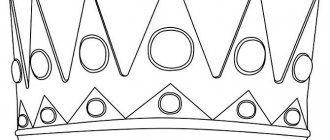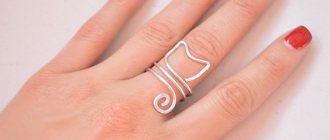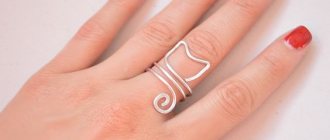The smart nails puzzle is a classic one, consisting of two identical nails.
The gap where the nails intersect is wider than the thickness of the nails themselves, so the nails can be connected to each other as well as separated without the use of force.
The apparent simplicity of this puzzle is what makes it great, and the solution to the puzzle is not as obvious as it seems at first glance.
This tutorial will show you how to shape the nails into the correct shape and, of course, how to solve the puzzle itself.
Manufacturing
There are so many options for wooden puzzles for children and adults. Next we will look at the most popular and common of them, which are easy to do yourself.
Cross OSS
To make this puzzle, you will need a rail whose width is three times the thickness, for example, if its thickness is 8 mm, then the width should be 24 mm.
The product is made as follows:
- A rail of suitable parameters must be cut into three parts of equal length.
- Next, in each plank you need to cut out a cutout corresponding to its cross section using a jigsaw. As a result, the strips should fit into this hole with little effort. Therefore, it is better for the window to be slightly smaller; in this case, you can bring it to the required parameters using needle files.
- You need to make a cut in the two slats on the side, the width of which should be exactly equal to their thickness. As a result, a T-shaped cut should be obtained in two parts.
- At the end of the work, the parts need to be sanded and varnished.
Assembling the OSS puzzle
This completes the puzzle making process.
Now you need to assemble it by following these steps:
- One of the parts with a T-shaped cutout must be inserted into the window, and it must be advanced so much that the end of the side cutout is “flush” with the surface of the strip.
- Next, you should take the third part and put it on top of the bar with the window until it stops.
- After this, you need to push down the first plank with a T-shaped cut all the way.
As a result, the puzzle takes on the appearance of a single piece.
Crossroads
To complete this craft, you will need a 1 cm square block.
The instructions for its manufacture are as follows:
- You need to cut three bars about 8-9 centimeters long from the slats.
- In the middle of one of them, you need to make a cutout 1 cm wide so that you end up with a square jumper with sides of 0.5 cm.
- The second part should be made in exactly the same way, only the jumper should turn out not square, but round.
- In the third block you need to cut a groove 0.5 cm deep and wide.
- Then the same block must be rotated 90 degrees, and another similar groove must be made on the adjacent surface.
- Next, all parts should also be sanded and varnished.
Puzzle assembly diagram
This completes the wooden puzzle.
Now it needs to be assembled as follows:
- Holding the block with two grooves vertically, you need to insert a part with a round jumper into it.
- A square puzzle is then inserted into the second slot.
- After this, the block with a round jumper must be rotated 90 degrees counterclockwise, after which the product will take the form of a non-scattering solid figure that is not easy to disassemble.
Note! In order for all the workpieces to turn out to be of high quality, they must be made from dry wood.
Makarov's puzzle
This craft is more complex, so before you start making it, it is advisable to complete a drawing. It must be said that DIY drawings of wooden puzzles do not have to be done to scale with high accuracy. The main thing is to indicate on them all the dimensions in millimeters and the main design features of the product.
Paper puzzles
It is important to get a child interested in crafts from an early age. The world of virtual games is not very useful for development. But working with paper and scissors will develop both imagination and finger motor skills, and the desire to do something with your hands, and not just watch cartoons. Also, by engaging in such creativity, children develop memory and neural connections that will help them learn further.
Many interesting things are made from paper. Various kusudama, toys and puzzles. But, of course, before you teach a child, you will have to learn how to make crafts yourself.
Young technician - for skilled hands 1975-12, page 4
ATTENTION! PUZZLE!
Puzzles are played without a partner. Whether you can guess the secret depends on your ingenuity. The polyhedron puzzle is not only a test of your intelligence, but also a good visual aid for the drawing room.
Before you is a drawing and drawings regarding
a relatively simple volumetric polyhedron consisting of six rectangular blocks. Five of them have cutouts (see picture above).
It is easiest to make such a polyhedron from soft woods - linden, alder, aspen, but it can also be made from harder ones, for example, from white
cuts or beech. The wood must be dry, otherwise, a month or two after manufacturing, the bars will lose their geometric dimensions - small gaps will appear between them, sometimes even invisible to the eye, and the bars will not fit tightly against each other.
To work, you will need a plane, a fine-tooth saw, a chisel, a square and a caliper.
Plan out the blank for the bars and check its cross-section with a caliper. It should be the same along the entire length. Cut the workpiece into bars and make cutouts in five of them. The distance between the upper edges of the cutouts should not be the same as shown in the drawings, but slightly smaller (by about 0.2 mm). Then the bars will be tightly connected to each other. Clean the finished, well-fitted bars with fine sandpaper and try to assemble the puzzle. Identical parts must be interchangeable, then the polyhedron will be a monolithic, non-disintegrating unit.
Now look at the picture below. These are also puzzles. Their base is the polyhedron you just made. Try making them yourself.
Of course, making these polyhedra is not easy, so we'll give you some tips. All three polyhedra, like a cube, have a common property: if you try to draw the missing projections of any of them, you will see that all three projections of each polyhedron are the same.
Polyhedron 1 will be obtained from the polyhedron made according to Fig. at the top, if two chamfers are cut at 45° from each end of the block, and polyhedron 2 is already a variant of polyhedron 1. The vertices of its outer corners must be cut off. Polyhedron 3... But we seem to have gotten carried away - the word is up to you, our young readers! Write to our editor about your successes!
V. GORYUNOV, designer Fig. S. PIVOVAROVA
4
We make our own geometric puzzles for toddlers and older children.
Content
By the age of 3, children begin to recognize geometric shapes and are able to determine size (large, small) and color. Find similarities and differences between figures. It is at this age that you can offer your child the first geometric puzzle as a game.
Unfortunately, it is very difficult to find material for this age. Either the sets have small parts, or they are difficult for the baby. We suggest making the first puzzle with your own hands. To do this, you can use cardboard, plastic or other suitable material that can be cut into pieces.
Development of useful skills
Modern children's wooden puzzles are the best choice for developing a huge number of skills a child needs.
After all, preschool and primary school age is the most important time when he can receive them. And solving wooden puzzles improves a whole host of skills! This is logical and spatial thinking, intelligence, memory, motor skills of hands and fingers, and much, much more.
Great preparation for school, isn't it? Having laid all these skills at this age, in the future the grown-up son or daughter will be able to use them when entering college and at work.
Young technician - for skilled hands 1985-09, page 9
Funland
VARIOUS
We have already told stories about them (see Appendix No. 12 for 1982), and today we will introduce a few more that were sent by our readers. But here are a few words about what is best to make them from. Wire puzzles are usually made from medium-stiff steel wire with a diameter of 2.5-3 mm. Copper or aluminum wire<1 is not suitable: it is too soft and does not spring well.
Important A device for marking the center of a part with your own hands
The gilded gold used for puzzles should first be straightened. Hold it firmly with your hands and pull it several times along a wooden cylindrical rod held vertically in a vice. Then sand until shiny with sandpaper.
Now determine the lengths of the individual sections of the selected puzzle and cut off the corresponding sections with wire cutters.
It is more convenient to bend the wire using a simple device - a piece of thick dog into which thick nails are hammered at the places where the wire is bent. Bend small rings and ears using pliers. To make large rings, you should prepare several wooden cylinders of different diameters in advance
The finished parts of the puzzles must be coated with 2-3 layers of non-colored varnish.
The parts (rings or staples) that are to be removed are blackened out in the drawings. They should be removed completely freely, you just need to figure out how to do it. Under the main picture of each holopuzzle there is an additional one that suggests the course of the solution.
STAR WITH SPOKE. It was invented by Alexander Trofimov from Leningrad. The diameter of the circle describing the five-pointed star is 100 mm. The diameter of ring 1 is 30 mm. It is 10 mm smaller than the diameter of the figured gray ring 2. The elongated part of the earring should fit freely into ring 1 and into the eye of the sprocket 3.
ANCHOR. The author of this puzzle is Seogey Yatsenko from Vladivostok. The height of the yakoya is 120 mm, and the width is 1С0 mm. Ring diameter 3 is 30 mm and ring diameter 1 is 40 mm. Part 2 should move freely at the base of the core.
FIGURED LINKS are offered by Selen Gorelishyaili from Baku. The dimensions of each ring formed by parts 2, 4 and 5 are chosen such that ring 1 can freely move only in the position indicated in the lower figure. The diameter of ring 1 is approximately 30 mm, and ring 3 is 40 mm.
ZIGZAG STAPLES. The dimensions of these scoo. as Yakov Sokolov from the Sverdlovsk region advises, you should make the following: brackets 2 and 3 - 40X50 mm, and the middle bracket 4 - 25XX50 mm. The diameter of ring 1 is no more than 35 mm.
9
How to play tangram
Each piece of the game must be made up of seven tangram parts, and they must not overlap.
The easiest option for preschool children 4-5 years old is to assemble figures according to the diagrams (answers) laid out into elements, like a mosaic. A little practice, and the child will learn to make figures according to the pattern-contour and even come up with his own figures according to the same principle.
Level one - download and print the colored tangram, this will make it easier to navigate the diagram.











